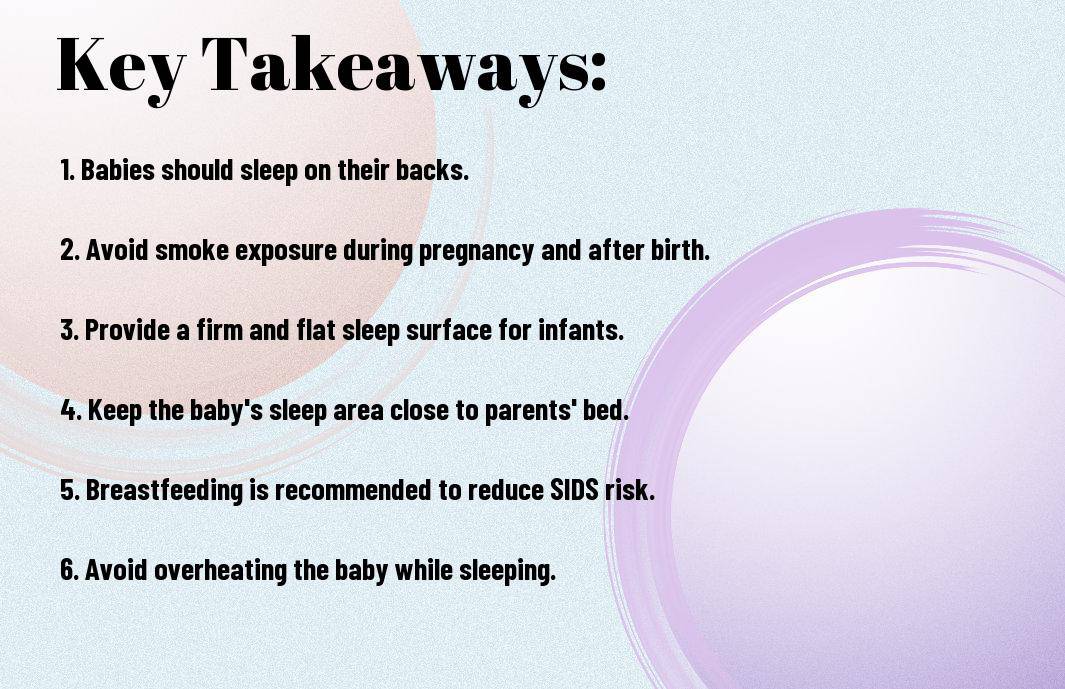tips, tricks and guides for parenthood
One of the most devastating realities for parents is the risk of Sudden Infant Death Syndrome (SIDS). This silent and sudden killer takes the lives of seemingly healthy babies without warning, leaving families heartbroken and bewildered. However, there are proactive measures that can significantly reduce the risk of SIDS and provide parents with peace of mind. In this article, we will explore vital strategies that can help protect infants and create a safer sleep environment to lower the chances of SIDS occurrence. By implementing these prevention strategies, we can work towards reducing the incidence of SIDS and safeguarding the lives of our little ones.

Identifying potential risk factors for Sudden Infant Death Syndrome (SIDS) is crucial in preventing this tragic event. Some factors to consider include smoking during pregnancy, exposure to secondhand smoke, premature birth, low birth weight, and placing your baby to sleep on their stomach or side.
Any parent or caregiver should be aware of these risk factors to create a safer sleep environment for their baby.
Ensuring your baby follows safe sleep practices is crucial in reducing the risk of SIDS. Simple steps such as placing your baby on their back to sleep, using a firm mattress in a safety-approved cot, and avoiding overheating can make a significant difference.
The implementation of safe sleep practices is paramount in providing a secure sleeping environment for your infant. The guidelines recommended by paediatric experts aim to minimise the risk factors associated with SIDS and promote a safe sleeping environment for your baby.
Ensuring maternal health during pregnancy is crucial in reducing the risk of Sudden Infant Death Syndrome (SIDS). Mothers should attend all antenatal appointments, avoid smoking, alcohol, and drug consumption, and maintain a healthy lifestyle. It is important for expectant mothers to follow safe sleep practices and educate themselves on ways to reduce the baby's risk. For more information, you can visit Ways to Reduce Baby's Risk.
After the birth of the baby, postnatal care and environmental considerations play a significant role in SIDS prevention. Parents should ensure that the baby sleeps on a firm, flat surface without any soft bedding or toys that could pose a suffocation risk. Room-sharing without bed-sharing is recommended for the first six to twelve months. The room temperature should be kept comfortable, and the baby should be dressed appropriately for sleep. Regular check-ups with the healthcare provider are important for monitoring the baby's growth and development. Overall, creating a safe sleeping environment is important to reduce the risk of SIDS.
Parental education plays a crucial role in reducing the risk of Sudden Infant Death Syndrome (SIDS). By educating parents on safe sleep practices, such as placing babies on their backs to sleep and keeping their sleep environment free of hazards, we can significantly lower the likelihood of SIDS occurring. Providing parents with accurate information and guidance empowers them to create a safe sleep environment for their infants, ultimately contributing to the prevention of SIDS.
Legislation and public health initiatives have proved to be effective in reducing the incidence of Sudden Infant Death Syndrome (SIDS). Laws requiring the use of safe sleep practices in childcare settings, as well as public health campaigns promoting safe sleep guidelines, have raised awareness and helped to prevent avoidable deaths. These initiatives play a crucial role in ensuring that parents, caregivers, and healthcare professionals are equipped with the knowledge and resources needed to protect infants from SIDS.
Advances in technology have led to the development of sophisticated monitoring devices that can track a baby's breathing, heart rate, and movement while they sleep. These devices come in various forms, from wearable monitors to mattress sensors, providing parents with real-time data to help reduce the risk of Sudden Infant Death Syndrome (SIDS).
Ongoing research is focused on enhancing monitoring devices to improve accuracy and reliability in detecting potential risks associated with SIDS. Future directions include integrating artificial intelligence algorithms to analyse data collected by these devices, which could lead to more accurate predictive models for early intervention and prevention strategies.
Implementing SIDS prevention strategies is crucial in reducing the risk of Sudden Infant Death Syndrome and ensuring the safety of infants. By following safe sleep practices, such as placing babies on their backs to sleep, using a firm mattress, and keeping loose bedding out of the crib, we can significantly lower the chances of SIDS occurring. Additionally, avoiding exposure to tobacco smoke during pregnancy and after birth, breastfeeding if possible, and ensuring a comfortable sleep environment at an appropriate temperature are also vital preventive measures. It is imperative for parents, caregivers, and healthcare professionals to be informed about these strategies and to consistently implement them to protect infants from this tragic and unexplained cause of death.
A: SIDS stands for Sudden Infant Death Syndrome, which is the sudden and unexplained death of an otherwise healthy infant, usually during sleep.
A: Common risk factors for SIDS include a baby sleeping on their stomach or side, exposure to smoke during pregnancy or after birth, overheating, and soft bedding in the sleep area.
A: Parents can reduce the risk of SIDS by placing their baby on their back to sleep, using a firm and flat sleep surface, keeping the sleep area free of soft bedding and toys, and avoiding overheating.
A: Yes, there are specific guidelines to follow for safe sleep practices to prevent SIDS, such as the ABCs of safe sleep: Alone, on their Back, and in a Crib. It is also recommended to avoid bed-sharing and use a pacifier during sleep.
A: In addition to safe sleep practices, reducing the risk of SIDS can also involve avoiding exposure to smoke during pregnancy and after birth, breastfeeding your baby, and ensuring they receive all recommended vaccinations.